|
June ITL Focus: IoT
ITL FOCUS is a monthly initiative featuring topics related to innovation in risk management and insurance.
This month's focus is Internet of Things

ITL FOCUS is a monthly initiative featuring topics related to innovation in risk management and insurance.
This month's focus is Internet of Things

|
Get Involved
Our authors are what set Insurance Thought Leadership apart.
|
Partner with us
We’d love to talk to you about how we can improve your marketing ROI.
|

Insurance Thought Leadership (ITL) delivers engaging, informative articles from our global network of thought leaders and decision makers. Their insights are transforming the insurance and risk management marketplace through knowledge sharing, big ideas on a wide variety of topics, and lessons learned through real-life applications of innovative technology.
We also connect our network of authors and readers in ways that help them uncover opportunities and that lead to innovation and strategic advantage.
The metaverse is a fascinating concept that has the potential to revolutionize the way we interact with digital content and each other.

KEY TAKEAWAYS:
--The use of virtual reality could transform claims, customer service, health and wellness, fraud detection and digital identity verification.
--Related technologies could allow for dynamic pricing, improve cybersecurity, risk assessment and predictive modeling and create revenue streams for insuring assets and activities within the metaverse.
----------
In recent years, the concept of the metaverse has gained significant attention as a potential game-changer in the way we interact with digital content and each other. Metaverse technology is being hailed as the next frontier in the evolution of the internet, with its potential applications ranging from gaming and entertainment to education, e-commerce and even insurance. In this blog post, we will explore the concept of the metaverse, its technology and its potential future in the insurance industry.
What Is Metaverse?
Metaverse refers to a virtual space where people can interact with each other and digital content in a shared immersive environment. It is a term coined by sci-fi author Neal Stephenson in his 1992 novel "Snow Crash." The metaverse is a vision of a fully immersive virtual world where users can engage with digital content in real time and in a highly interactive manner.
What Is Metaverse Technology?
Metaverse technology is a combination of various digital technologies such as virtual reality, augmented reality, blockchain and artificial intelligence. Virtual reality technology enables users to experience a simulated environment that is immersive and interactive. Augmented reality enables users to enhance the real world with digital content. Blockchain provides a decentralized and secure platform for transactions and interactions within the metaverse. Artificial intelligence is used to create intelligent virtual agents and chatbots that can interact with users in a natural language.
Future of Metaverse in the Insurance Industry
The insurance industry could potentially benefit from metaverse technology. The metaverse could be used to create virtual insurance offices, where customers can interact with agents in a virtual environment. This could significantly reduce the need for physical offices and reduce costs. The metaverse could also be used to create immersive training simulations for insurance agents, where they can learn how to handle different situations in a virtual environment.
The metaverse could also be used to enhance the claims process. For example, a customer who has been involved in an accident could use augmented reality to capture images of the accident scene and upload them to a virtual claims office. The insurance company could then use blockchain to securely store the data and process the claim. This could significantly reduce the time and cost involved in claims.
Challenges
While the potential of the metaverse is significant, there are also several challenges that need to be addressed. One of the biggest is interoperability. There are multiple metaverse platforms being developed, and they do not necessarily work with each other. This could lead to fragmentation and limit adoption.
Another challenge is privacy and security. The metaverse involves the collection and processing of large amounts of personal data. This data needs to be protected from unauthorized access and use.
See also: Time to Start Issuing Metaverse Policies?
Here Are 10 ways the Metaverse Will Revolutionize Insurance
Conclusion
The metaverse is a fascinating concept that has the potential to revolutionize the way we interact with digital content and each other. Metaverse technology is still in its early stages, but it is rapidly evolving and could have significant implications for various industries, including insurance. While there are challenges that need to be addressed, the future of the metaverse looks promising, and it will be interesting to see how it evolves.
Get Involved
Our authors are what set Insurance Thought Leadership apart.
|
Partner with us
We’d love to talk to you about how we can improve your marketing ROI.
|

Abhishek Peter is an assistant manager at Fecund Software Services.
Peter possesses a master's degree in marketing.
The recent $4.5 billion valuation of Wefox makes no sense. It shows that investors haven't yet learned the lessons of Lemonade, Hippo and Root.

Let's make some new friends....
This month, Wefox did a new round of financing at a $4.5 billion valuation. This valuation makes no sense!
At current market prices, you can buy pretty interesting insurance targets with this amount. Moreover, I doubt any investor would accept exchanging stocks in an equity-only merger with Wefox.
This nine-year-old startup, with about $1.4 billion in cumulative funding, is:
The insurance arm (Wefox Insurance AG) underwrote EUR196 million in 2022 -- with a bloody 95% gross loss ratio -- and generated $30 million of underwriting losses. Premiums intermediated on their platform are at EUR2 billion.
Do you remember my doubt four years ago about whether we were dealing with unicorns in insurtech or with ponies in Halloween costumes? Or, my rant about Root's multibillion--dollar valuation?
Here we are again!
----------
Talking about valuations: I did my first exit a few weeks ago.
As many of you know, Andrea Battista and I promoted a special purpose acquisition company in 2018, and we acquired Net Insurance with the money raised. The combined entity did pretty well. Insurtech solutions have been used to execute the vision as planned. Long story short, Poste Italiane made a public offer on the company in September, and in the past weeks they completed the acquisition.
There was a 120% return for SPAC investors in four years! And the acquisition price of about EUR175 million is at a P/E multiple that makes sense for a good insurance company.
Andrea's unwavering dedication, strategic vision and profound expertise have guided Net Insurance's successful journey. I desire to show my gratitude for the opportunity he gave me to contribute to this adventure. This has been an unforgettable experience, a constant intellectual challenge, an honor and an extraordinary opportunity to learn from exceptional and experienced professionals, such as the board chair, Luisa Todini.
See also: 7 Key Trends in 2023
----------
Let's stay on my personal experience over the last month. On May 8 in Johannesburg, I had the privilege to present at Vitality Distribution Network Annual Summit to executives from all their global partners. It was a great opportunity to discuss the evolution of the shared value approach and to hear directly the perspective of tens of different insurers from Japan, Asia, Europe, North America and South America.
After moments like this, you really understand the privilege of talking directly and spending hours with players from different markets, rather than relying only on reading articles or press releases coming from these markets. I'm blessed for these opportunities, even if to fit them into my agenda I have to sleep on planes and take showers in the lounges of airports some days each week.
At the event, I had the opportunity to enjoy the speech of Andrew Sykes.
First, he is one of the best speakers I've ever seen on an insurance stage. He has become my benchmark: I aspire to become as good as him (even with my heavy Italian accent) at some point in my journey.
Second, his speech was extremely thought-provoking. His presentation was about trust. The basics of trust are:
The journey of the business combination between our SPAC and Net Insurance did precisely this! We declared up-front what we would do and how we wanted to use data and technology to do it. The team did a fantastic job overdelivering:
Here, I'm documenting.
These steps are the opposite of what the first generation of insurtech startups did. Basically, they overpromised, underdelivered and periodically twisted the narrative (or documented exotic key performance indicators).
In the first edition of this newsletter -- 15 months ago -- I asked if Lemonade fans felt betrayed about overpromising and underdelivering. In the fall of 2018, we heard, "Europe, forget everything you know about insurance!" Hundreds of insurtech cheerleaders clapped their hands and celebrated the inevitable disruption of the European markets.
After four years, Lemonade has written EUR4.3 million in premiums in Europe. This is not a typo. Their current European book of business is the same size as the portfolio of that old insurance agency at the corner of your street.
The other U.S. full-stack insurtech carriers have not been more trustworthy:
However, now I have a new friend to play with: Wefox.
I want to sincerely congratulate your leadership team for the successful financing rounds, even in this market contingency. However, you are repeating a playbook that lacks any of the basics of trust.
In September 2022, at an event in Zurich, you presented this chart, claiming to have a "loss ratio more than 10 percentage points better than the market average." But you added an exotically adjusted benchmark, saying you were calculating based "ON THE BACK BOOK."
See also: A Look Ahead for Insurtechs in 2023
These are the actual results of your auto insurance business ("Solvency & Financial Condition Report 2022"):
Motor vehicle liability
Other motor insurance
With such KPIs, it would be more serious and trustable to say something like, "our loss ratio is terrible, and we are working to improve it." Instead, your statements after the financing round go even beyond overpromising.
I hope the new generation of insurtechs will not follow this playbook, too. I hope they will promise less and deliver more... so they can proudly document everything. I hope the next generation of insurtech innovators will be trustworthy leaders who can strengthen our sector!
Get Involved
Our authors are what set Insurance Thought Leadership apart.
|
Partner with us
We’d love to talk to you about how we can improve your marketing ROI.
|

Matteo Carbone is founder and director of the Connected Insurance Observatory and a global insurtech thought leader. He is an author and public speaker who is internationally recognized as an insurance industry strategist with a specialization in innovation.
41% of millennials with insurance purchased it with their mobile device, and other generations are moving in that direction, too.

KEY TAKEAWAYS:
--Premium payments are people's most common interaction with their insurance company, so great care should be paid to mobile design and communication.
--Adoption of digital payments should be encouraged, and QR codes can be a great, convenient tool.
--Digital wallets are spreading fast, and the industry should start preparing now.
----------
In my over 25 years of experience in the insurance payments space, I have rarely seen change occur so rapidly.
In a June 2020 McKinsey survey, 73% of finance industry executives said they saw the pandemic as an opportunity for growth, but only 21% felt they had the means to pursue that opportunity. Three years later, pressure from the pandemic, coupled with customers McKinsey describes as “expect[ing] nothing less than…ease and convenience” due to digitalization in other industries, have pushed the insurance industry closer to an innovation breaking point. In their State of Digital Insurance, 2021 report, Forrester described the pandemic as having “turbocharged and changed the drivers of digital transformation in insurance.”
Driven by these industry trends, a valuable locus for this energy is continual innovation around customers’ mobile payments experience. According to a survey conducted in January 2021 by InvoiceCloud, 41% of millennials with insurance purchased their policy using their mobile device. Research from AARP, published this past January, demonstrates that 86% of seniors own smartphones, making them a potentially viable market for the ease and reliability of mobile payments, as well. And, as the oldest members of tech-native Gen Z begin driving, graduate from their parents’ life insurance policies and even purchase homes, the cohort looking for mobile insurance bill payment ease shows the potential to grow.
I expect streamlined mobile payments to be at the forefront of meeting those expectations. While it’s infrequent that an individual policyholder needs to call on their insurance company for a major payout, maintaining the policy itself is a monthly affair. This means that premium payments are many policyholders’ most common touchpoint with their insurance company. What’s more, InvoiceCloud’s October 2022 State of Online Payments Report indicated that mobile payment channels have overtaken online portals as the most used and preferred method of bill payments, with 67% of survey respondents reporting that they used a mobile device to pay a bill in the preceding 12-month period, as compared with only 63% of respondents reporting that they used an online portal to pay a bill during that same period.
Here are some steps that I encourage your organization to take to offer policyholders across all demographics a more effective mobile payment experience.
Mobile-Friendly Design and Communication
Despite the ubiquity of mobile devices and the rising popularity of mobile payments, in my view too many insurance organizations still fail to design their user interfaces and experiences with a mobile-first mindset. Keeping consumers satisfied requires catering to the payment methods that suit them best—and, for an increasing number of consumers, that means leveraging the digital innovation boom to streamline mobile payments. Whether consumers are managing payments in a dedicated app or via a mobile browser, creating an accessible experience is important.
Mobile bill payers can also benefit from design choices like larger text, more succinct language and other elements that make information easier to parse when presented on a smaller screen. Taking notes from a recent study conducted by the Journal of Medical Internet Research focused on design choices that facilitated better experiences for people accessing healthcare information via mobile device, the insurance industry could learn from the benefits of substituting graphics for words where possible, increasing download speeds and including a consistently accessible search function. Insurance organizations should also look to ensure that their mobile offerings fit the dimensions of a mobile screen. While computer monitors are wide, phone screens are tall, so interfaces that center important information in the middle of the screen can help reduce the amount of scrolling customers have to do to access options. While this may seem like a small consideration, it can help to reduce friction for those making mobile payments.
The high number of mobile device users also presents a valuable opportunity for insurance companies to streamline their payments experience as a whole. Organizations can send customer communications via text, optimized for the mobile platform. Alerting customers in advance of when their payments are due and including information about, and links to, payment options can help organizations reduce delinquencies, simply by making it easier to pay a bill right then and there. InvoiceCloud’s September 2020 State of Online Payments Report showed that of the 60% of respondents who said they’d missed a bill payment, half of those respondents believed a text message reminder would’ve helped them remember to pay on time.
Collecting customer responses about what they are looking for from their payments experience is critical when deciding how to direct innovation. Insurance organizations can survey users to determine which mobile features they feel would make bill payment easier. By following these trends and responding with continued innovation, an effective payments partner will be in a better position to give organizations tools that meet customers’ most current needs.
See also: The B2B Digital Payment Opportunity
Encouraging Digital Adoption and Augmenting the In-Person Experience with QR Codes
QR codes are a prime example of mobile-native technology and are continuing to grow in usage, according to McKinsey. As reported by eMarketer, a total of 75.8 million people scanned a QR code in the U.S. in 2021, and by 2025 they predict that 99.5 million people in the U.S. will use QR codes. This trend opens a valuable opportunity for the insurance industry. Insurance organizations that still have a high number of customers receiving paper bills should consider taking advantage of the direct route to the consumer by including a QR code on mailings. Upon scanning with a mobile device, consumers can then be prompted to follow instructions to enroll in paperless billing, meaning companies may be able to use this touchpoint to save funds by reducing paper bills. QR codes aside, encouraging paperless billing has the potential to bring an organization substantial savings—in one case, an InvoiceCloud customer saved tens of thousands of dollars on paper printing costs by driving paperless billing enrollment.
Encouraging automatic payment (AutoPay) is another important avenue for insurance organizations to explore. As automatic payments become increasingly popular for the convenience they offer customers (InvoiceCloud’s October 2022 State of Online Payments showed a 5% increase in respondents reporting that they were enrolled in AutoPay as compared with respondents surveyed in 2021), many customers will seek an expedited way to make the switch. Those customers looking for an insurance partner they can trust now and into the future may also be more attracted to an insurer that offers modern payment options like AutoPay and continually expands and improves those offerings.
While there will undoubtedly be some customers who will prefer to maintain in-person payments, particularly as pandemic-era restrictions and concerns continue to ease, there are still ways an insurance organization can incorporate mobile offerings to improve the overall customer experience. For example, insurance companies and agents could post QR codes throughout their brick-and-mortar offices to help customers more easily navigate the payment process—essentially putting instructions in the palm of their hand. Using such methods to help drive digital adoption can also help save time and resources for organizations’ employees, as the amount of time spent manually facilitating each payment can be reduced.
In balancing this innovative, tech-centric approach, insurance organizations can also benefit from implementing security measures such as hard-to-replicate design choices recommended by Forrester, while continuing to innovate with solutions that marry security and ease.
Streamlined Digital Wallets
JD Power’s Banking and Payments Intelligence Report found that more and more customers are using digital wallets facilitated by services such as Apple Pay, Google Pay and PayPal. McKinsey predicts that more than two-thirds of Americans will have a digital wallet within the next two years. As the country becomes more accustomed to this technology, people are likely to begin using their digital wallets for increasingly routine and important payments, such as insurance premiums.
Once customers connect their payment information via a mobile wallet, a reminder email or text can be immediately transformed into an on-time or early payment with minimal friction. Customers can also use digital wallets to load and toggle between multiple payment methods, which McKinsey found was a preferred method of 40% of digital wallet users. This helps lower the barrier to payment that customers may face when attempting to shift between accounts to access funds or use different payment types for different policies.
See also: The Evolution of Frictionless Payments
It Pays to Understand What Customers Want Out of Mobile Payments
As I see it, providing a positive payment experience via the most common channel, mobile, is more important than ever. In 2020, 41% of insurance policyholders surveyed by PwC said they were “likely or more likely” to switch carriers, owing specifically to their current carrier’s lacking digital capabilities. A 2022 PwC study found that one in three customers will walk away from a company after just one negative experience.
The rapid innovation of the market has made it easier for insurance customers to compare, shop for and switch carriers. At the same time, that innovation offers an opportunity: McKinsey found that insurance organizations leading the industry in digital innovation increased revenue at five times the rate of other companies.
Ultimately, insurance is a business of relationships, built on a foundation of trust and reliability. Creating ease for customers in every interaction, particularly at the most common touchpoint of payments, is an important method of building loyalty and driving business. Insurance organizations looking to retain their current customers and attract new ones should explore how improving their mobile payments experience can help them achieve both.
Get Involved
Our authors are what set Insurance Thought Leadership apart.
|
Partner with us
We’d love to talk to you about how we can improve your marketing ROI.
|

Julie Schieni is VP, financial services, at InvoiceCloud.
She has over 25 years of experience in insurance and information technology. She has held leadership positions in software companies and property and casualty insurance carriers.
In the decades I've been immersed in technology and innovation, I've never seen anything adopted nearly as fast as generative AI.

While you've been hit in the face for months now with articles about the importance of generative AI models like ChatGPT, and while they aren't always that helpful — "Generative AI is really important"; "Actually, it's really, really important"; "No, it's really, really, really important" — I'm going to risk another one.
I won't get into the broad significance, which will play out over many years and which others are speculating on at great length. But I do think it's worth noting some ways that financial services firms are already taking advantage of the leap forward in AI.
Venture capital firm Andreessen Horowitz laid out the most provocative set of examples I've yet seen. The article is aimed broadly at financial services but, with just a bit of thinking, can be applied to insurance, specifically.
The article summarizes the opportunities by saying:
"We believe that the financial services sector is poised to use generative AI for five goals: personalized consumer experiences, cost-efficient operations, better compliance, improved risk management and dynamic forecasting and reporting."
The article describes ways that conversational AI could help provide advice on credit, wealth management and taxes — which require much the same sort of counseling that insurance agents provide and that can now be enhanced. For starters, a large language model (LLM) "trained on a company’s customer chats and some additional product specification data should be able to instantly answer all questions about the company’s products," the article says
It argues that the world should head toward continuous underwriting (specifically for mortgages, but the same thinking could apply for insurance policies). The holdups are that data is siloed, that emotions complicate many financial decisions and that financial services are highly regulated. But Andreessen Horowitz says, "Generative AI will make the labor-intensive functions of pulling data from multiple locations, and understanding unstructured personalized situations and unstructured compliance laws, 1000x more efficient."
For instance, the article notes that, "at every bank [or insurance carrier], thousands of customer service agents must be painstakingly trained on the bank’s products and related compliance requirements to be able to answer customer questions. Now imagine a new customer service representative starts, and they have the benefit of having access to an LLM that’s been trained on the last 10 years of customer service calls across all departments of the bank. The rep could use the model to quickly generate the correct answer to any question and help them speak more intelligently about a wider range of products while simultaneously reducing the amount of time needed to train them."
Or, "loan officers [read, underwriters] currently pull data from nearly a dozen different systems to generate a loan file. A generative AI model could be trained on data from all of these systems, so that a loan officer could simply provide a customer name and the loan file would be instantly generated for them. A loan officer would likely still be required to ensure 100% accuracy, but their data-gathering process would be much more efficient and accurate."
Combatting fraud is another near-term opportunity. The article says, "Today, the billions of dollars currently spent on compliance is only 3% effective in stopping criminal money laundering. Compliance software is built on mostly 'hard-coded' rules. For instance, anti-money laundering systems enable compliance officers to run rules like 'flag any transactions over $10K' or scan for other predefined suspicious activity.... Now imagine a model trained on the last 10 years of Suspicious Activity Reports (SARs). Without needing to tell the model specifically what a launderer is, AI could be used to detect new patterns in the reports and create its own definitions of what constitutes a money launderer."
There's more, too, in the article, on potential operational efficiencies and on how the AI can draw on unstructured data such as news reports to automatically generate important insights on risks. So, I recommend reading and pondering the whole piece.
I also recommend thinking hard about the long-term implications. The rule of thumb about breakthrough technologies is that they're overestimated in the short term but underestimated in the long term.
But, for now, I want to be sure we don't miss the potential short-term wins.
As I wrote back in February, I think the efforts by ChatGPT and other generative AIs in the near term should be viewed as rough drafts, not finished products. (Here is a remarkable story from last week, showing that not everyone has gotten the memo about how generative AIs can "hallucinate." A lawyer had ChatGPT do some research for him and submitted it as part of a brief, only to find that the AI had invented numerous court cases and citations. The judge is not amused.)
But I also think those rough drafts can be extremely valuable — and they'll improve remarkably fast.
In general, even a genuine technology breakthrough faces a chicken-and-egg problem initially and takes time to shake the world. The internet traces back to the 1960s but needed three decades to develop enough reach to change commerce. As revolutionary as the iPhone launch was in 2007, apps needed to be developed and telecom carriers needed to adapt before we all became addicted to our phones.
But AI, having incubated since the 1950s, is just software. Its latest, breakthrough form doesn't require you to wait for a network to develop or for thousands of companies to develop apps.
It's there, waiting to be exploited, both in the long run and even in the short run.
Cheers,
Paul
Key insights into the relationship between inflation and insurance replacement costs as basis for P&C / Non-Life capital allocation line performance, and solvency
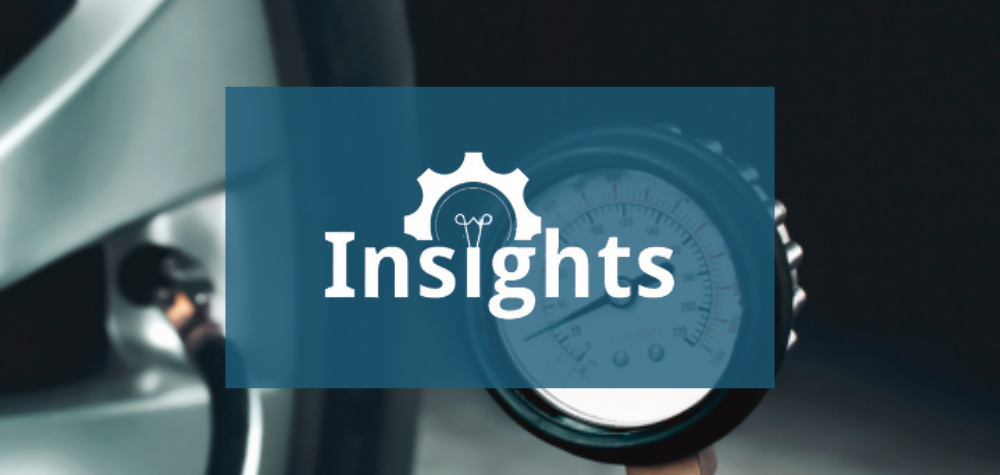
Synopsis/Summary: This executive briefing looks at the relationship between overall inflation and insurance replacement costs in six of the world’s largest insurance markets: the U.S., Canada, the U.K., the E.U., Japan and Korea.
Specifically, the briefing’s analysis focuses on P&C/non-life replacement costs for commercial and personal property and personal and commercial vehicles including construction materials, auto and auto parts and labor. The results provide correlation estimates across and within each country, organized first around property and then vehicles, identifying statistically significant and non-significant coefficients that confirm and question received expectations.
The briefing’s analysis builds on the authors’ research at the Insurance Information Institute on overall inflation and P&C replacement costs in the U.S. Applications include business strategy, planning, and maximizing underwriting performance and solvency during times of economic stress such as the current high inflation environment.
* * *
Key insights into the relationship between inflation and insurance replacement costs as basis for P&C / Non-Life capital allocation line performance, and solvency
This executive briefing looks at the relationship between inflation and P&C/Non-Life insurance lines in the United States, Canada, the United Kingdom, the European Union, Japan and Korea. It aims to provide the reader preliminary insight into the quantitative relationship between overall inflation and insurance replacement costs within and across the covered countries. We define insurance replacement costs, as opposed to a country’s overall inflation, as the average increase in prices for specific goods and services paid by a P&C/Non-Life towards repair and rebuild costs for total losses paid.
Correlation patterns for changes in residential and commercial property replacement costs identified three distinct groups: the U.S., Canada and the E.U. were correlated to one another with different degrees of significance, while Japan and Korea showed no significant correlation to one another or any of the other countries. Personal and commercial auto correlation patterns also identified three distinct groups overlapping with those of property, though Korea showed some significant correlation with the U.K. and the E.U.
Quantifying the relationship between inflation and insurance replacement costs across national and regional P&C/Non-Life insurance markets can provide an additional framework to maximize insurance capital allocation, including reinsurance capacity, by seeking uncorrelated underlying economic fundamentals and insurance performance metrics. Further, separating correlated and uncorrelated line-specific insurance replacement costs drivers can increase the ability to forecast line-specific performance metrics and provide added guidance to industry stakeholders, including regulators, seeking to maximize liquidity and solvency during times of economic stress such as the high inflation that characterized the COVID-19 pandemic and its aftermath.
In a very preliminary manner, the correlation analysis reported in this briefing indicate that it may be possible to minimize the impact of historically high increases in P&C/Non-Life replacement costs by diversifying exposure to property and auto lines by selecting different insurance markets based on the extent of correlation between overall inflation and replacement costs across and within countries. For example, pending further research and validation, grouping the six countries we reviewed into three cohorts may reduce the drag of historically high replacement costs on individual lines’ performance metrics; these cohorts being the U.S., Canada, the U.K. and the E.U.; a stand-alone Korea; and a stand-alone Japan.
In the U.S., the difference between increases in overall CPI versus changes in insurance replacement costs has proven to be significant. Between 2019 and 2022, increases in P&C replacement costs averaged twice that of the overall CPI. Given this spread, insurance replacement costs baskets are becoming a more precise and timely input into forward looking loss estimates and the impact of inflation on line-specific performance metrics.
This briefing is divided into four sections. First, it introduces the distinction between overall inflation and insurance replacement cost and its relevance to our understanding of how macroeconomic fundamentals drive insurance performance.
It then seeks to identify and quantify correlations between overall inflation and replacement costs within and across the sample countries, for property and then autos. The analysis of property and auto replacement costs, the core of this briefing, provide descriptive year-over-year and year-over-five-year inflation estimates, and correlation analysis of the relationship between price changes for each line within and across the covered countries. The last section describes the methodology including additional inflation and correlation graphs and tables.
This briefing’s scope is limited: it explores correlations between overall inflation and replacement costs for property and auto only; restricts itself to descriptive statistics rather than inference; and pairs inflation components from different national inflation metrics indices even though those may not fully overlap in their individual definitions. The methodology section expands on these insight and limitations.
This briefing’s analytical framework draws from Triple-I’s research into the relationship between overall inflation and insurance replacement cost in the United States over the last three years. That methodology deconstructs the U.S. CPI Urban-all items into separate goods and services baskets aiming to be most representative of specific insurance lines’ “repair and rebuild” costs.
 The U.S. experienced the highest five-year cumulative inflation between 2018 and 2022 of the cohort. Over that period, overall U.S. inflation on a cumulative basis reached 20.7%. The U.S. was closely followed by the E.U. at 20.31%, the U.K. at 17.7%, Canada at 17.0%, Korea at 11.9%, and Japan at 3.3%. This stands against a backdrop of correlated overall inflation across the six countries. This is against a backdrop of overall inflation correlated to various significant degrees across the U.S., Canada, the U.K., and Korea, but not across those countries and Japan and the E.U.
The U.S. experienced the highest five-year cumulative inflation between 2018 and 2022 of the cohort. Over that period, overall U.S. inflation on a cumulative basis reached 20.7%. The U.S. was closely followed by the E.U. at 20.31%, the U.K. at 17.7%, Canada at 17.0%, Korea at 11.9%, and Japan at 3.3%. This stands against a backdrop of correlated overall inflation across the six countries. This is against a backdrop of overall inflation correlated to various significant degrees across the U.S., Canada, the U.K., and Korea, but not across those countries and Japan and the E.U.
Cumulative increases in property replacement costs were higher than overall inflation in the U.S., Canada and Japan. Conversely, overall inflation was higher than increases in property replacement costs in the U.K., the E.U. and Korea.
Over the same period and across the six countries, the U.S. experienced the highest cumulative increases in property replacement costs at 30.4%, followed by Canada, the E.U., the U.K., Korea and Japan. Property replacement costs correlations grouped the six countries into three cohorts: the U.S., Canada, the U.K. and the E.U.; a stand-alone Japan; and a stand-alone Korea. The four countries in the first cohort show different degrees of correlation significance with one another while the second and third cohorts show no correlation with either of the other cohorts or any of the other countries. Within the first cohort, Canada is strongly correlated to the E.U. Property replacement costs in Canada are strongly correlated to the E.U.’s but weakly to U.S.’ and the U.K.’s.
Summary rational for the above relationships include the relative weight of property cost drivers within each country’s inflation baskets, construction material sourcing, free-trade blocs and domestic credit intermediation to name a few. We suggest further review.
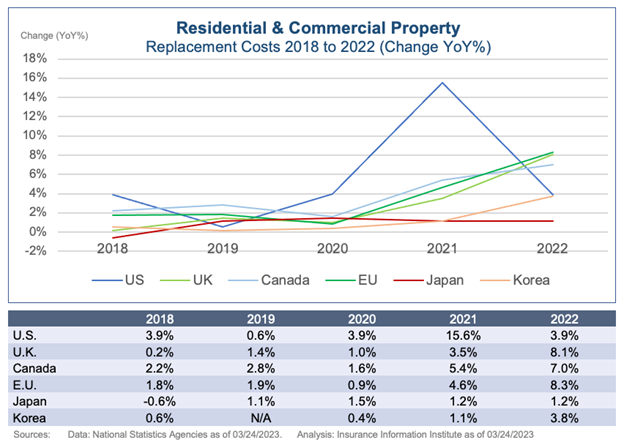
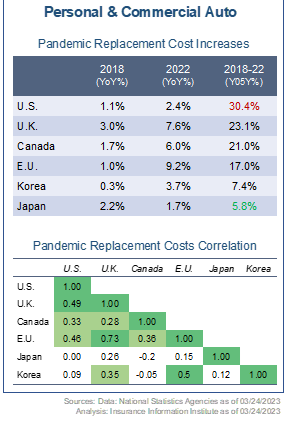 Looking at the relationship between auto replacement costs and inflation within each of the six countries from 2018 to 2022, replacement costs correlate with overall inflation in the U.S., Canada, the U.K., and the E.U.. However, they do not correlate with overall inflation in Japan and Korea. Cumulative increases in auto replacement costs were higher than overall inflation in the U.S., the U.K., Canada, and Japan. Conversely, overall inflation was higher in the E.U., while Korea saw auto replacement costs increase less than overall inflation.
Looking at the relationship between auto replacement costs and inflation within each of the six countries from 2018 to 2022, replacement costs correlate with overall inflation in the U.S., Canada, the U.K., and the E.U.. However, they do not correlate with overall inflation in Japan and Korea. Cumulative increases in auto replacement costs were higher than overall inflation in the U.S., the U.K., Canada, and Japan. Conversely, overall inflation was higher in the E.U., while Korea saw auto replacement costs increase less than overall inflation.
Over the same period and across the six countries, the U.S. experienced the highest cumulative increase in auto replacement costs at 30.4%, followed by the U.K., Canada, the E.U., Korea and Japan. Auto replacement costs correlations grouped the six countries into three cohorts: a first cohort with different degrees of significant correlation between the U.S., the U.K., the E.U., and Canada; a second cohort between Korea, the U.K., and the E.U.; and third cohort made of a stand-alone Japan. Within the first cohort, the strongest correlations are between the E.U. and the U.K., then those two countries and the U.S., and only last yet still significant the relationship between those three countries and Canada.
Even though it is beyond this briefing’s scope to move from descriptive statistics to inference, it is worth noting that supply chain integration seems to have less impact on replacement costs than might have been otherwise expected. The weaker yet significant correlation between replacement costs in the U.S. and Canada, which arguably share a single supply chain, compared to the stronger correlation between replacement costs in the lesser chain-integrated U.S., U.K., and E.U., point to the other determining intermediary variables. We suggest further review.
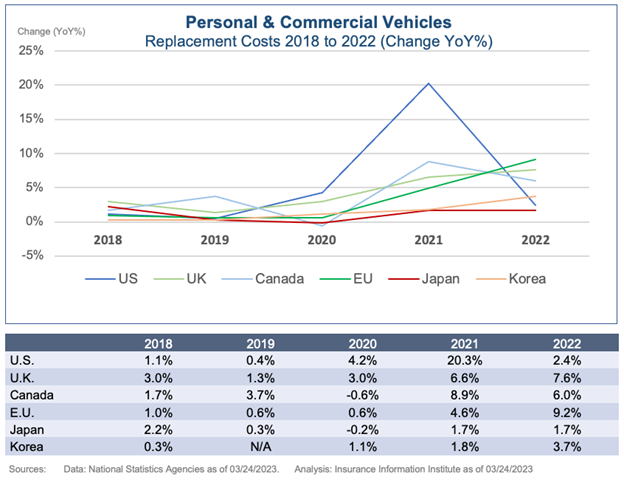
Aligned with the Triple-I’s mission to provide actionable data-driven insight to the P&C industry, our replacement costs framework uses publicly available government data for the major level-1 CPI or PPI components, those just below the index itself. In its current form, the selection of basket components is based on claims patterns and major categories for repair and rebuild by line. The recomposed line-specific baskets are weighted to qualitatively match loss patterns. We are currently using machine learning trees to optimize both the selection and the weighting of each line-specific basket. We expect to publish preliminary results of this analysis this summer.
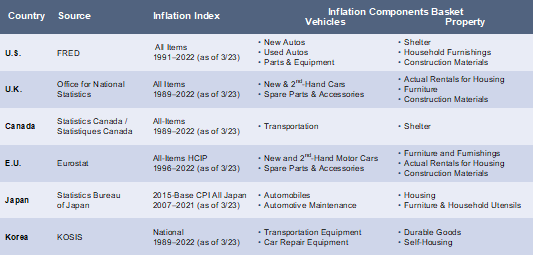
We chose to gather data directly from national statistical reporting agencies rather than rely on international agencies or multi-laterals. This decision was based on data availability and timeliness, consistency and familiarity for economists following each country, and better control over inflation basket component selection and taxonomy. We acquired roughly thirty years of data from national statistical agencies where possible or, otherwise, as much as was available. Because there is little international uniformity in inflation reporting, we had to find approximates and equivalent data to the lines we use in constructing replacement costs estimates for individual U.S. P&C lines.
Given the constraints under which we were working, we were unable to access inflation data for specific consumer items in Canada, and instead used the generalized categories of Shelter and Transportation, which include often-volatile fuel price data. Japanese data was only available starting in 2007 and, due to reporting lags, lacked 2022—this was the most limited country in the analysis cohort. In addition, we had trouble accessing data relating to construction materials. It is worth noting that much of the data for E.U. was available, but referred to by different labels (i.e., Second-Hand Cars instead of Used Autos, or Actual Rentals for Housing instead of Shelter). This data was otherwise equivalent.
Once monthly index data was acquired, the rate of inflation for each year was calculated as the percent change from December of the previous year to December of the year in question for each data series. This is in keeping with the generally accepted practices of reporting annualized inflation. In addition to translating the raw data into the more familiar inflation rates, this also deserialized the data and made erroneous correlation less likely. To calculate inflation over several years, we calculated the product of the inflation rates of the intermittent years.
Homeowners and Auto replacement costs were calculated as the unweighted averages of housing-related inflation rates and auto-related inflation rates, respectively. With the lines of business aggregates calculated, we generated correlation matrices across-country for each line-of-business plus overall inflation, and within-country matrices across data series. Since correlation coefficients require paired data, each pairing of country was limited to the lesser of the pair. For example, since Japan had the fewest observations, its pairings were limited to 14 observations.
We also calculated the p-values of each correlation based on the t-distribution to evaluate the robustness of each correlation coefficient. (The p-value represents the probability of making a false-positive error in examining statistical measurements, thus the lower the p-value the more robust the measurement is). We labeled correlations with p-values between 0.10 and 0.01 as weak (colored light green), and correlations with p-values less than 0.01 as strong (dark green). This is consistent with regular practices in academia.
The matrices of correlation coefficients were color-coded based on coefficient robustness, providing a road map for examining the relationships between countries, input sources, and how trends in one country can cascade through supply-chains. There are some obvious limitations to relying on correlations; however, this provides a manageable survey of connections and trends, and represented the first step one would take in developing more causal links.
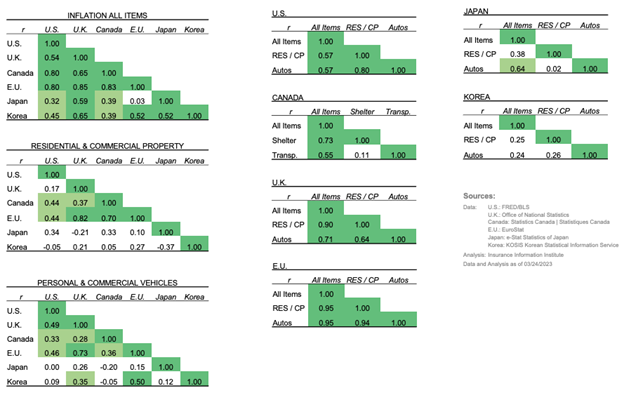
* * *
By Michel Leonard, PhD, CBE, Chief Economist & Data Scientist, and Riley Conlon, Research Analyst,
The Insurance Information Institute
The Insurance Information Institute reserves the right to change, improve or correct the information, materials and descriptions in this report. The information contained herein is the work of Triple-I analysts and contains information from third party sources. Triple-I gives no guarantees, undertakings, or warranties concerning the accuracy, completeness, validity, or timeliness of the information provided. Independent confirmation of the accuracy of the information contained herein is recommended. Any dated information is published as of its date only.
5.2023

Michel Léonard
Chief Economist & Data Scientist
The Insurance Information Institute
Dr. Michel Léonard, CBE, is the Insurance Information Institute’s Chief Economist and Data Scientist. He brings more than twenty years of insurance experience including senior and leadership positions. In these roles, he worked closely with underwriters, brokers and risk managers to model risk exposures for property-casualty and specialty lines such as credit, political risk, business interruption and cyber. Dr. Leonard is also Adjunct Faculty in New York University’s Department of Economics. He is a member of the Insurance Research Council Advisory Board.

Riley Conlon
Research Analyst
The Insurance Information Institute
Riley Conlon joined Triple-I’s Economics and Analytics Department as a Research Analyst. He is responsible for providing analysis and insight on insurance and economic conditions, and developing forward-looking statistical models. He also consults the greater Triple-I team on becoming a more data driven institution. Previous experience includes research roles with Mission Measurements, New York University Department of Economics, and Sonoma State University Department of Economics. Riley holds a Bachelor of Arts in Economics, a Bachelor of Science in Statistics and a Bachelor of Arts in Pure Mathematics from Sonoma State University, and a Master of Arts in Economics from New York University, focusing on Quantitative Economics.
Get Involved
Our authors are what set Insurance Thought Leadership apart.
|
Partner with us
We’d love to talk to you about how we can improve your marketing ROI.
|

IIS serves as the inclusive voice of the industry, providing a platform for both private and public stakeholders to promote resilience, drive innovation, and stimulate the development of markets. The IIS membership is diverse and inclusive, with members hailing from mature and emerging markets representing all sectors of the re/insurance industry, academics, regulators and policymakers. As a non-advocative organization, the IIS serves as a neutral platform for active collaboration and examination of issues that shape the future of the global insurance industry. Its signature annual event, the Global Insurance Forum, is considered the premier industry conference and is attended by 500+ insurance leaders from around the globe.
Thought provoking insights on the evolving insurance claims landscape. Swiss Re's first issue of their bi-annual magazine sharing trends that are shaping the claims environment and perspectives in both global outlooks and local realities.
Using geospatial imagery, property insurers can identify unique exposures, such as roof characteristics and tree overhang, that help to improve risk determinations.
bolttech has launched a new whitepaper with GSMA and Mobile World Live, exploring how telcos can capture the next wave of growth through embedded insurance.
Updating technology is essential but perceived as costly and difficult. Here’s our guide for property and casualty carriers.
Five key practices for a patient-centered approach are most effective in mitigating potential chronic pain issues in workers’ compensation.

KEY TAKEAWAYS:
--The first four key practices are: determining compensability quickly; communicating the claims process and status to the injured worker; providing quality, evidence-based medical care; and identifying delayed recovery factors.
--Perhaps the most important practice is working with the doctor and employer to encourage stay-at-work (SAW) and return-to-work (RTW), even when that requires modified duties.
----------
Injured workers often feel lost in the complex workers’ compensation benefit delivery systems. Difficult to understand, these systems leave injured workers confused, disbelieved and disrespected, which feeds a sense of hopelessness and abandonment. This can potentially contribute to the development or instigation of chronic pain perceptions and a poor outcome.
There are five key practices for a patient-centered approach that, when quickly addressed, are most effective in mitigating potential chronic pain issues in workers’ compensation. The first four are: determining compensability; communicating the claims process and status to the injured worker; providing quality, evidence-based medical care; and identifying delayed recovery factors. Perhaps the most important practice is working with the doctor and employer to encourage stay-at-work (SAW) and return-to-work (RTW), even when that requires modified duties.
Prompt communication among the healthcare provider, patient, employer and any other stakeholder to expedite treatments for the employee to return to full functionality and work will lead to the best outcome. For many workers, it is work itself that acts as a preventative measure as it supports an employee’s perception of being valued.
Factors That Contribute to Creating a Chronic Pain Patient
To support health, employers can provide a work environment that protects and promotes workers’ physical and psychological health and safety. Doing so requires attention to how cases of injured workers are handled. Let’s take a look at several workers’ compensation factors that contribute to creating a chronic pain patient:
Delayed recovery and ever-worsening disability are often even more pronounced in individuals with poor coping skills and other behavioral, characterological, personality and psychological issues. Underlying personality structure and motivation are often determinants for disability. Chronic pain complaints may be linked with significant disability.
See also: State of Mental Health in the Workplace
What Can Be Done?
By facilitating better medical outcomes, we can get injured employees back to work faster and steer clear of the traps that can lead a patient into a downward spiral, both medically and psychologically. There are nine key factors that influence positive outcomes:
Better, faster medical outcomes are a win-win for injured workers and their employers. Following these best practices can more effectively address the needs of injured workers and provide them with the attention they deserve, resulting in getting back to work faster and a positive experience overall.
As first published in WorkCompWire.
Get Involved
Our authors are what set Insurance Thought Leadership apart.
|
Partner with us
We’d love to talk to you about how we can improve your marketing ROI.
|

Dr. Annu Navani is the chief medical officer for Boomerang Healthcare, with more than 20 years of experience in the medical industry.
Dr. Navani completed her anesthesiology residency at the Medical College of Wisconsin, Milwaukee and a fellowship in pain medicine from the University of California, Davis. Over the last decade and a half, she has served as founder and CEO of Comprehensive Spine and Sports Center.
Dr. Navani is an adjunct clinical associate professor at the division of pain at Stanford University. Dr. Navani sits on the editorial board of the journal Pain Physician and serves on the board of the American Society of Interventional Pain Physicians, the Ortho Biologic Institute Networks, California Society of Industrial Medicine and Surgery and California Society of Interventional Pain Physicians.
She has also written several national guidelines, including on opioids, interventional spine epidural procedures, facet joints and biologics in the lumbar spine.
The industry kids itself about having gone paperless. In fact, we still use the same processes we used in the 17th century. It's time for a change.

KEY TAKEAWAYS:
--A typical process involves routing the submission to a lower-cost resource, often offshore, who might extract and convert 50 of the 500 important pieces of information in it into digital data.
--But tools that combine natural language processing with computer vision can now extract all the key data from both structured and unstructured documents with great accuracy and speed.
----------
For over a decade, we have pretended to be paperless. We tout the fact that the file cabinets, the seven-part specialized file folders and massive mail rooms have all been eliminated and reduced, and we claim we are paperless. But we know we aren't. Today’s paper is PDFs, Excels and Adobe.
The filing cabinets have been replaced with digital folders and the mail rooms with emails and digital workflows. But insurance isn’t paperless; it just pretends to be.
It doesn’t have to be that way. The technology to become truly digital exists. We just need to take the leap.
One of the biggest hurdles to being truly digital as opposed to being a digital paper industry involves the initial ingestion or digitization of the data. We have had advanced OCR and computer vision solutions for a while. These have been great at extracting the information from digital forms and standardized templates but have not met the needs of more complex undertakings such as commercial insurance submissions.
The typical commercial insurance new business submission or quote request can contain an application, loss runs, statement of values, insurance certificates, financial statements and many other documents, depending on the type of insurance. A typical commercial insurance submission will contain 300 to 500 pieces of information. Information that is invaluable in understanding, evaluating and quoting a piece of business.
The untapped potential of dark data
Our processes today to extract the data from these submissions are archaic. A typical process involves routing the submission to a lower-cost resource, often offshore, who will extract a minimum set of fields to set up the submission and some basic rating information. On a good day, they might extract and convert 50 of the 500 pieces of information into digital data by entering it into the system. The rest is left in the documents as dark data. Data that the carriers have, but that is never digitally exposed or available.
Then the electronic file, carrying the electronic documents, is sent along to the underwriter, where these digital documents are opened again and again because the data isn’t available. Other than the file folder and the documents being made out of bits and bytes rather than paper and ink, it is the same process as 300 years ago.
It doesn’t have to be that way. We have seen what insurance can become with speed, efficiency and precision when the process is digital with simpler and homogeneous risks in personal lines, but the promise is there for more complex insurance such as group benefits, commercial lines and specialty insurance. And it starts by being able to digitally ingest the data.
This is where we have seen a technological leap. With the integration of more advanced machine learning tools that can combine natural language processing with computer vision, data can now be extracted from both structured and unstructured documents with high degrees of accuracy and speed. In fact, this is one of the hottest emerging technology areas in insurance today with a wide array of players and investors. Take the case of a life insurer in China that has deployed an intelligent risk control system that enables end-to-end automation of insurance applications. (See, Fuel the future of insurance)
See also: Seeing Through Digital Glasses
Learn from the emerging leaders
One of the other emerging leaders in this space is a company called MEA out of the U.K. What makes MEA unique is that it was founded by insurance executives who understand the unique challenges involved in complex insurance documents as well as having a key understanding of the terminology, variability and complexity involved. Their solution has focused on building deep expertise and a broad insurance-specific extraction catalog around core insurance concepts, starting with submission documents that allow their solution to be quickly adapted to new insurance areas. The best part is that, because their team deeply understands insurance, working with them does not require you to train their team on what insurance means.
We have worked with MEA on several engagements and tests throughout Europe and the U.S. The breadth of their solution has allowed us to evaluate a wide range of lines of business, business processes and insurance entities including carriers, MGAs and brokers. They can consistently compete in terms of speed, accuracy and quality in their testing and execution. It is really possible to be going from evaluation to use of this type of solution within a few short months.
So, what does this mean for our digital paper world today? Well, it means insurers now have a real choice to begin a digital journey. This has been the hope and dream for a while, but technology has really caught up to that vision of being digital – starting with intelligent ingestion.
Creating truly touchless processes
There are several different ways in which to now employ it. It starts by identifying a pseudo-paperless process that exists in your organization today and targeting the documents that it ingests. Submissions are an obvious choice, but claims, bordereaux, invoice receipts, audits, etc. are all also possible. Then design how you want the digital process to work. You can choose to ingest and directly process the data or take a more cautious approach that still includes some level of human review or human insight.
The choice should depend on the complexity and significance of the data and your comfort with implementing it, but long term you should expect that at least some portion of your ingestion will be able to be touchless. The other decision to make is whether you are only going to extract the data that you use today or do you want to extract everything in the document. This is the 50 versus 500 question for submissions. But you may require some other changes and other technology to aid a true digital transformation. We will discuss those elements in a future blog.
In the meantime, however, isn’t it time that your insurance process was no longer from the 17th century? Isn’t it time that we moved from passing along the digital paper in email and workflow systems to building truly digital processes? Isn’t it time to start to build your company’s intelligent ingestion solution? Let’s start to build real digital insurance.
You can find this article originally published here.
Get Involved
Our authors are what set Insurance Thought Leadership apart.
|
Partner with us
We’d love to talk to you about how we can improve your marketing ROI.
|

Michael Reilly is a managing director in Accenture's insurance strategy practice.
He has 20 years experience helping insurance companies to transform underwriting operations and organizations around the world; he has led large-scale commercial insurance transformation programs in underwriting, policy, business intelligence and mergers and acquisitions.
Reilly has also co-written and presented multiple articles on underwriting, analytics and knowledge management and worked at General Accident Insurance prior to joining Accenture.
In commercial insurance, customers and providers can look forward to an improved experience as the market shifts toward online channels.

KEY TAKEAWAYS:
--Currently, non-core activities absorb roughly 40% of underwriters' time. Traditional manual quote and pricing processes are too time-consuming, especially as consumers demand quotes in hours rather than days or week.
--Luckily, scalable and authoritative data is accelerating the transition to automated models.
--91% of commercial insurance customers said they would get a quote online — but only 28% had. The gap means there is a significant opportunity for insurers willing to invest in streamlined, automated processes.
----------
2023 is the year of hyper-digitalization in commercial insurance; providers have recognized the benefits of automation and are embracing it. As the industry evolves, insurers are bringing the advantages of cutting-edge technology and advanced data capabilities to agents and the businesses they represent.
An improved customer experience was cited as a top priority by the Council for Independent Agents and Brokers (CIAB) in its annual outlook report. This new, streamlined purchasing process benefits clients and policy providers alike by enhancing the agent and customer experience while improving efficiency. It also means valuable insights for underwriting and pricing. Insurance companies that have adopted this approach have a significant advantage over their competition, which translates to sustainable profits in a competitive marketplace.
Changing Legacy Processes Across the Value Chain
Historically, commercial insurance was a highly manual, high-touch business. The detailed nature of the work could lead to significant price quote delays. Underwriters manually verified different aspects of risk — the type of business, number of employees, financial situation, etc. — because legacy data systems could not process complex business transactions and data sources were fragmented.
This was especially true for small and micro-businesses, where insurance underwriting is highly volume-driven. The low margins associated with these types of businesses, and the high costs that come with them, make high-touch underwriting impractical.
Commercial insurance is in high demand, with the U.S. receiving more than 400,000 new business applications every month since the start of the pandemic. Currently, non-core activities absorb roughly 40% of underwriters' time, which amounts to approximately $85 billion to $160 billion in efficiency losses over a five-year span. And consumer demand calls for quotes in hours rather than days or weeks. Traditional manual quote and pricing processes have become too time-consuming, particularly within these small and micro-business segments.
Further, the legacy approach runs the risk of error and lost or incomplete data. Under the traditional process, insurers may find it challenging to develop an accurate picture of business risks or to make informed pricing and policy decisions.
Luckily, scalable and authoritative data is accelerating the transition to automated models. AI-based processes and alternative data sources, such as aerial imagery, offer new insights detailing a small business's historical information, assets and exposures. Automated processes ensure that all the information is complete and accurate while minimizing the amount of manual data entry needed.
See also: Insurers Turn to Automation
Evolving Channels Improve Agent Insight
This technological shift has enabled insurance companies to offer a broader range of value. Commercial insurance agents have always brought vital advice and expertise to the industry. And as data sources become more accurate, agents can increasingly focus on the most complex transactions, offering specialized services and a more personal client experience.
Channel evolution is a crucial part of this improved customer experience. It introduces more online quoting and binding into the underwriting process. For example, in the latest TransUnion Annual Insurance Outlook Survey, 91% of commercial insurance customers said they would get a quote online — but only 28% had. These results indicate a gap in commercial insurance offerings and a significant opportunity for insurers willing to invest in streamlined, automated processes.
The transition to purchasing policies online is a natural evolution for many business owners. They already purchase their personal insurance policies online and are willing to obtain commercial insurance the same way. As a result, most independent insurance agents anticipate a significant increase in online commercial insurance buyers over the next three years.
Although online channels are evolving, digitalization does not diminish the agent's role. Instead, it evolves it. Insurers will continue to use agents to acquire larger and more complex policies. Most agents know this and are responding by deepening their industry knowledge through investments in education and technology to better serve their clients and remain competitive in the marketplace. According to CIAB's annual outlook report, agents are also offering additional payment methods, improving application and renewal processes, hiring specialized personnel to improve the client experience and prioritizing additional client services.
Increasing Automation Leads to Better Allocation
Agents are just one resource providers can look to as proof of technology's benefit. Commercial insurance provider expense loads remain high, and automation helps insurers balance those costs while better allocating resources. With the influx of data providers using AI and other digital technologies, it has become increasingly mainstream for commercial insurers to automate portions of their underwriting and pricing processes.
Only a few industry pioneers have delved into this space in recent years. Now it’s becoming a progressively more common practice. With digital imagery and AI-based information collection processes, there is now an overwhelming number of solution providers in this landscape. For example, for many small business classifications, such as artisan contractors, automation is relatively commonplace, with a large amount of publicly available data. In the past, underwriters would review these risks and make pricing adjustments. Digital technology can streamline these simple underwriting processes and quickly generate a quote based on real-time data.
See also: Where Small Commercial Insurers Are Investing
As the underwriter's role evolves due to technology, it becomes more focused on data analysis and identifying unique risks that don't fit into these data-rich categories. To optimize these efforts, commercial insurers are channeling their dollars where it makes more sense. Highly complex cases benefit from strong underwriters and agents deeply involved in the policy.
At the same time, tech tools are available to streamline less complicated cases where scalable data is more readily available. This approach allows insurers to bring down expense loads faster.
Digitalizing Is Commercial Insurance’s Path Forward
The commercial insurance industry continues its digital transformation and is not stopping anytime soon. Today's business insurance customers expect a convenient and seamless purchasing experience — one-third of consumers will walk away from a trusted brand after a single poor experience. Digitalization is crucial to client retention and acquisition.
Commercial insurers are turning to digital channels and using available data to meet these expectations and stay competitive in the marketplace. This move allows them to offer their customers more efficient, personalized service and stay ahead of the competition while improving their bottom lines. By embracing digital technologies, commercial insurers can enhance the consumer experience, improve their process and remain price-competitive for more homogeneous risks.
Get Involved
Our authors are what set Insurance Thought Leadership apart.
|
Partner with us
We’d love to talk to you about how we can improve your marketing ROI.
|

Patrick Foy is senior director of commercial insurance strategic planning at TransUnion.
Specialty markets have fallen behind the pack on innovation, and many markets are threatened. But they don't have to be.

KEY TAKEAWAY:
--With the introduction of digitization and a focus on innovation, processes can be streamlined by allowing customers to purchase policies online, file claims on their mobile devices and receive real-time updates on their claims. This level of convenience may not be new to other sectors of the insurance industry, but it certainly is for specialty markets like those for boaters and water sports.
----------
In insurance, “specialty” has been left vague over the years. To me, it simply means niche, misunderstood, non-traditional, volatile. These characteristics all naturally drive away risk-bearing entities.
As a result, specialty markets have fallen behind the pack when it comes to innovation. The status quo has been rising premiums, abandoned markets and limited underwriting appetite. A lot of markets are threatened.
But they don't have to be.
Take boating and water sports, a threatened market where insurers have shown less appetite every year and premiums have shot up. With the introduction of digitization and a focus on innovation, processes can be streamlined by allowing customers to purchase policies online, file claims on their mobile devices and receive real-time updates on their claims.
This level of convenience may not be new to other sectors of the insurance industry, but it certainly is for specialty markets like those for boaters and water sports.
Renters historically were uninsured, which left a huge gap in coverage if they were involved in an accident. Renters found themselves either paying a large sum out of pocket or bringing a lawsuit against the business they rented from. But digitization makes it easy to offer renters a low-limits insurance policy to cover their exposure.
The result is a much healthier rental ecosystem for all involved and offers a model that can open up more insurance markets for rental businesses as a byproduct.
See also: How AI Can Solve Prior Authorization
The adoption of next-gen insurance tech in the “specialty market” mitigates risk immensely compared with the more archaic forms of operations that rental companies have been using for their entire lifespan. The new model rids them of uncertainty, volatility and misunderstandings.
The trick is to streamline the necessary processes through innovative yet user-friendly technology: doing things right but also efficiently.
By using technology, insurance companies can improve the customer experience, better understand risk and tailor policies to specific areas or activities.
As boating and water sports and other activities continue to grow in popularity, insurance companies must adapt and provide policies that cater to the unique needs of their customers.
It’s time we bring some clarity to specialty markets and provide solutions that have served larger markets for years. Not only is there a grave need for insurance in these niche areas, but there is also a huge opportunity. The insurance industry’s mission must be to continue to bring these innovative solutions across specialty rental markets from land to sea.
Get Involved
Our authors are what set Insurance Thought Leadership apart.
|
Partner with us
We’d love to talk to you about how we can improve your marketing ROI.
|

Cam Serigne is CEO and founder at vQuip.
He began his career in the NFL ,where he had a brief stint with the New Orleans Saints and Carolina Panthers as a tight end. After the NFL, he joined Ridgemont Equity Partners, where he worked across the technology, business industrial services, energy and healthcare sectors, collaborating with management teams to solve some of their most difficult problems.
Serigne left to start vQuip, a technology company dedicated to solving compliance and operational risks that have plagued the boat rental industry.